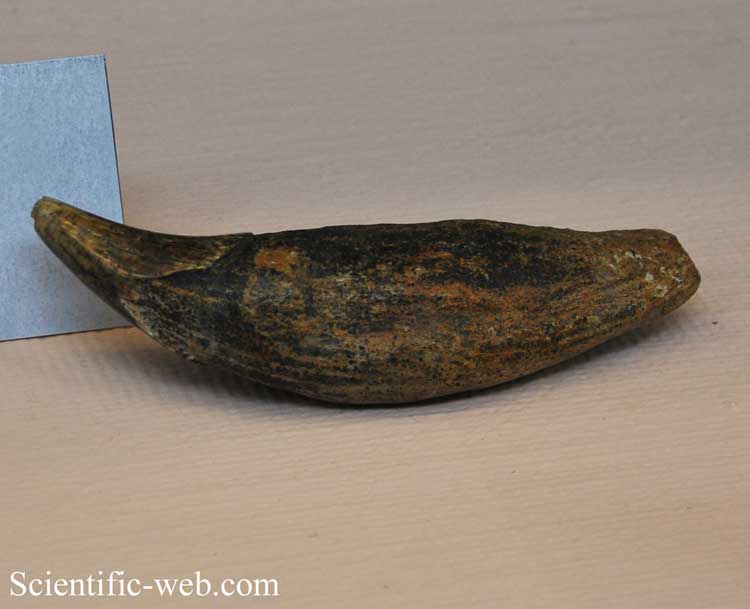
Ursus deningeri, Deninger's bear tooth, Photo: Michael Lahanas
Superregnum: Eukaryota
Regnum: Animalia
Subregnum: Eumetazoa
Cladus: Bilateria
Cladus: Nephrozoa
Superphylum: Deuterostomia
Phylum: Chordata
Cladus: Craniata
Subphylum: Vertebrata
Infraphylum: Gnathostomata
Superclassis: Tetrapoda
Cladus: Reptiliomorpha
Cladus: Amniota
Cladus: Synapsida
Cladus: Eupelycosauria
Cladus: Sphenacodontia
Cladus: Sphenacodontoidea
OrdoTherapsida
Cladus: Theriodontia
Subordo: Cynodontia
Cladus: Mammaliaformes
Classis: Mammalia
Subclassis: Trechnotheria
Infraclassis: Zatheria
Supercohort: Theria
Cohort: Eutheria
Cohort: Placentalia
Cladus: Boreoeutheria
Superordo: Laurasiatheria
Cladus: Ferae
Ordo: Carnivora
Subordo: Caniformia
Familia: Ursidae
Genus: Ursus
Species: †Ursus deningeri
Ursus deningeri (Deninger's bear) is an extinct species of bear, endemic to Eurasia during the Pleistocene for approximately 1.7 million years, from 1.8 to 0.1 million years ago.
The range of this bear has been found to encompass both Europe and Asia, demonstrating the ability of the species to adapt to many Pleistocene environments.
U. deningeri is a descendant of U. savini and an ancestor of U. spelaeus.
Morphology
Skull of Ursus deningeri
Ursus deningeri has a combination of primitive and derived characters that distinguishes it from all other Pleistocene bears. Its mandible is slender like that of living brown bears and Ursus etruscus. It also has derived characters of cave bears (Ursus spelaeus) and is considered to be the descendant of Ursus savini and very close to the common ancestor of brown bears.[3]
Fossil distribution
Sites and specimen ages:
Nalaikha, Mongolia: ~1.8 Mya to 800,000 years ago
West Runton Freshwater Bed, Cromer Forest Bed Formation, Norfolk, England: ~800,000–100,000 years ago
Cueva del Agua, Granada, Spain: ~800,000–100,000 years ago
Venosa bed excavations 1974–1976, Basilicata, Italy: ~800,000–100,000 years ago
Emirkaya-2, Central Anatolia, Turkey: ~800,000–100,000 years ago
Sima de los Huesos, Atapuerca, Spain: >300,000 years ago[4]
Darband Cave, Alborz, Caspian, Iran: ~300,000–200,000 years ago
Stránská skála (Ursus Cave), Brno, Moravia, Czech Republic: excavations 1943–1944 ~790,000–600,000 years ago[5][6]
Genetics
In 2013, a German team reconstructed the mitochondrial genome of an Ursus deningeri more than 300,000 years old, proving that authentic ancient DNA can be preserved for hundreds of thousand years outside of permafrost.[7]
References
Ursus deningeri in Inventaire National du Patrimoine Naturel (in French)
García, N., Santos, E., Arsuaga, J. L., & Carretero, J. M. (2007). Endocranial morphology of the Ursus deningeri von Reichenau 1904 from the Sima de los huesos (Sierra de Atapuerca) middle Pleistocene site. Journal of vertebrate paleontology, 27(4), 1007–1017.
García, N., & Arsuaga, J. L. (2001). Les carnivores (Mammalia) des sites du Pléistocène ancien et moyen d'Atapuerca (Espagne). L'anthropologie, 105(1), 83–93.
Dabney, J., Knapp, M., Glocke, I., Gansauge, M. T., Weihmann, A., Nickel, B., Valdiosera, C., García, N. Svante, P., Arsuaga J., & Meyer, M. (2013). .Complete mitochondrial genome sequence of a Middle Pleistocene cave bear reconstructed from ultrashort DNA fragments. Proceedings of the National Academy of Sciences, 110(39), 15758-15763.
Mlikovsky, J. (1964). Early Pleistocene birds of Stránská Skála Hill, Czech Republic: 1. Musil’s Talus Cone. Stránská Skála Hill. Excavation of open-air sediments, 1972, 111–126.
Musil, Rudolf (ed.1995): Stránská skála Hill. Excavation of open-air sediments 1964–1972. Antropos, Brno 1995, ISBN 978-3-7749-2798-8
Dabney & al. 2013. PNAS. "Complete mitochondrial genome sequence of a Middle Pleistocene cave bear reconstructed from ultrashort DNA fragments" doi: 10.1073/pnas.1314445110 PNAS
Biglari, F., V. Jahani (2011). "The Pleistocene Human Settlement in Gilan, Southwest Caspian Sea: Recent Research.". Eurasian Prehistory 8 (1–8 (1–2): 3–28.
Retrieved from "http://en.wikipedia.org/"
All text is available under the terms of the GNU Free Documentation License

